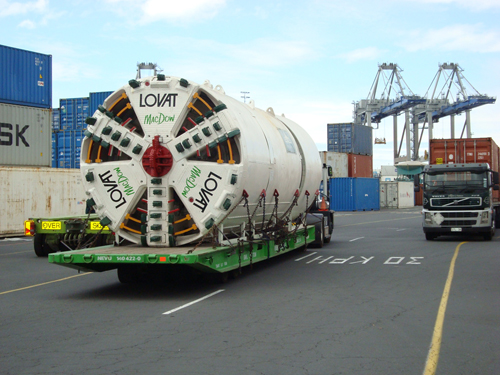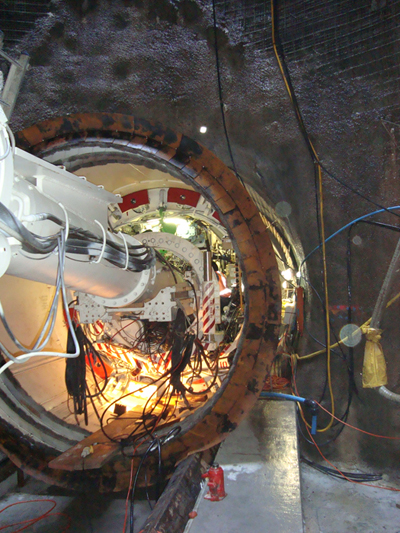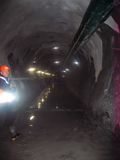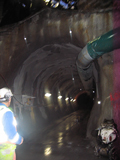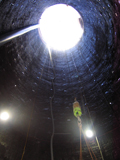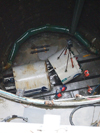McConnell Dowell securing hard-won and award winning successes in New Zealand and Australia
Feb 2009
Shani Wallis, Editor
-
Founded in New Zealand in 1960 by Malcolm McConnell and Jim Dowell, the company of their names’ sake is fast becoming a principal player in the mid to large range tunnelling market in the Pacific Rim region. Last year (2008), TunnelTalk visited four of the company’s current tunnelling projects to appreciate the scope of the undertakings and to know how each is contributing to the company’s expanding portfolio of experience and adding to an impressive list of previous successes. The four projects visited are the award winning access tunnel contract for the new Pike River coal mine development on the west coast of New Zealand’s South Island; the Rosedale outfall and Hobson Bay sewer tunnel contracts in Auckland, New Zealand; and the Bogong hydropower headrace tunnel in the Snowy Mountains of northern Victoria, Australia. The second article in the series describes mobilisation of the Rosedale project.
Design-build responsibility at Rosedale
Feb 2009
- The 5.1km Rosedale outfall project in Auckland turned from an original design-bid-build contract, based on shallow tunnels and open-cut work, to a deep level design-build alternative.
- Developed for North Shore City Council by its consultant Maunsell AECOM in 2003, the alternative is for a 3km deep level tunnel from the inland treatment works, out under the shoreline to a seabed riser in Mairangi Bay, and into a 2.1km buried ocean pipeline to a multi-pipe diffuser. The project is needed to replace the existing 50-year old tunnel and near-shore outfall; to increase discharge capacity from the existing 1.15m3/sec to 6m3/sec to accommodate current and future growth in Auckland’s North Shore City suburbs; and to extend effluent discharge some 2.7km off-shore into waters of about 12m deep to protect the quality of the area’s beaches.
-

Treated effluent will discharge some 2.7km out into Mairangi Bay
- According to Lalith Fernando, Project Manager for North Shore City Council, it was review of market conditions that turned the owner’s project into a lump-sum, fixed-price, design-build alternative. “This is the largest civil project the Council has ever undertaken and design-build also moves the project into construction more rapidly, once awarded, and improves the prospects of having the job completed within the 2010 permits we have for major construction works in the area from the Auckland Regional Council. The risk of construction price controls and timeline deliveries also moves from us to the experienced contractor. We had to get this right, and the risk of design also moved to the contractor under the design-build procurement process.” Prior to the Rosedale project, design-build had been used successfully for procurement of the Browns Bay sewer tunnel completed in 2006, and the Silverfield detention tank in 2004 for North Shore City Council.
- To meet the strict goals for a new 6m3/sec capacity 100-year design life outfall in operation by June 2010, proposals for a design-build contract based on FIDIC Terms and Conditions, were called in September 2006. Three prequalified teams were invited to submit tenders by the March 2007 deadline. The process however, faced serious disarray when the two international JV tenderers pulled out before tenders were due. This left McConnell Dowell with its design consultant Connell Wagner-DC as the only bidder.
- Subsequent negotiation with the sole bidder and under an alternative Early Contractor Involvement type of arrangement, with strict auditing to assure value for money for the owner, had a NZ$92 million design-build contract agreed and awarded with McConnell Dowell by August 2007. This was a higher bid price than the client’s estimate, but within a budget that had spent some NZ$16 million since start of project development in 1999.
-
Deep level benefits and concerns
The client’s original design included sections of pipe-jackings and open trenching. Although more expensive,
-

Fig 1. The original shallow pipe jacking and open trench alignment
- the McConnell Dowell alternative for a deep alignment TBM tunnel project had several advantages. It eliminated open cut through the suburbs and centered most of the construction work for the landward section at the Council’s Rosedale treatment plant site. As part of this contractor-driven initiative, the North Shore City Council invoked its North Shore Drainage Board Act for the first time to acquire the right to pass under private property and take a straighter route to the sea beneath the area’s high-value residential suburbs. This eliminated the intermediate shaft needed on the original shallow alignment to incorporate sharp turns to stay under public right-of-way.
- The original shallow alignment designed by Maunsell AECOM was based on cores from 25 boreholes. McConnell Dowell with Connell Wagner completed a programme of 19 more boreholes for its deep tunnel alternative.
- The geology of the area is medium-strength sedimentary rocks of the East Coast Bays Formation (ECBF) with sandstone and siltstone deposited in thin laminated layers.
-

Main construction site at the Rosedale treatment plant
- A cliff face at the seafront, where the tunnel passes out from the land drive to the ocean riser some 600m off shore, illustrates clearly the thin horizontal laminated deposits.
- To work in these conditions, McConnell Dowell purchased a new 3.2m o.d. LOVAT EPB TBM to excavate the 3km long landward tunnel and build a 2.8m i.d. gasketed lining comprising precast, steel fibre reinforced, concrete segments that are temporarily bolted.
- Making a success of the tunnelling work however was not the main concern for the project in the early stages. McConnell Dowell has solid experience of tunnel drives of this diameter and length and also with operating LOVAT machines. The bigger concern for the design-build contract after award was for design of the structures and their performance in operation.
-

Thin laminated sedimentary rocks cause hydro-fracturing concern
-
Internal pipeline pressure
The 5.1km long outfall will operate at an internal pressure of 2.5 bar to convey flow from the drop shaft at the treatment plant, through the 3km, 1:90 downhill gradient tunnel, up the 35m deep intermediate riser, and along the 2.1km long buried seabed pipeline to the multi-pipe diffuser head. The first major concern was that for two-thirds of the bored tunnel, the net internal hydraulic pressure might exceed the external ground and ground water pressure giving rise to the risk of leakage through the segment joints and of hydro-fracturing the laminated, medium-strength sedimentary rocks. - As an immediate mitigation, the elevation of the tunnel was lowered by 15m in anticipation of increasing the confining pressures around the segmentally lined tunnel. The main access shaft, as well as the treatment plant drop-shaft; the permanent access shaft at the sea shore; and the marine riser, all had to be extended by the additional 15m.
- Another design concern was configuration of the effluent drop-shaft at the head of the long outfall. Studies revealed a potential for air entrainment within the proposed vortex shaft design, and for explosive release of that entrained air. Mitigating this risk has resulted in selection of a much larger diameter ‘cascade’ drop shaft structure.
- In the meantime, the tunnelling operation is on track. When TunnelTalk was on site, the temporary access shaft was complete and a 75m starter tunnel and 50m backshunt were complete and ready for casting of the final in-situ concrete lining over the primary shotcrete lining. The access shaft had been sunk using sheet-piles and precast concrete whalers for the top 12m to the rock interface, and by excavator with wiremesh and rockbolts through the rock section to depth. The starter tunnel and backshunt had been excavated using a small roadheader boom and a mechanical breaker fitted to a tractor boom. In-situ concrete lining of the headings was about to begin using a 3.7m i.d. refurbished form used previously on the McConnell Dowell Project Hobson tunnel project.
-

Precast whalers in the access shaft
- Since then, the new TBM has arrived from Canada and after assembly at the bottom of the shaft, was launched in January 2009. The cutterhead of the new 3.2m o.d. LOVAT machine is fitted with rippers and scrapers (discs are not needed) and the six gasketed segments in each 1m wide ring are lifted and placed with a mechanical segment erector. A soil conditioning system is incorporated into the TBM and annular back-grout is injected through the segments. Behind the TBM, diesel locos haul trains of segment wagons, a grout car and muck skips up the 1:90 gradient to the 44m deep x 10m diameter access shaft at the treatment plant site. Skips are lifted to the surface for discharge and muck is being disposed of as landfill on the large area of land owned by the Council at the Rosedale site.
- “We will operate the machine 24 hours a day on two 12h shifts/day rotation and have set a program advance of 19m/day to intersect with the undersea riser in about 10 months,” said Greg Wichman, Project Manager for McConnell Dowell. “At the end of the drive we will retrieve the internal components of the machine and abandon the shield as part of the permanent works. Hand mining from a tunnel breakout will complete the junction with the pre-installed 35m deep x 1.5m diameter GRP pipe riser and we’ll use the same riser installation barge to lay the 2.1km HDPE buried pipeline and the diffuser section at the far end.”
-

Seatow barge installing the seabed riser
- When asked why not tunnel the whole way to a riser at the diffuser end, Mike Bonnette, Construction Manager for McDonnell Dowell said that the buried pipeline is more cost effective. “The seabed pipeline is a permitted method,” he said, “and we are taking the tunnel 600m out under the bay to a location where the riser is founded entirely in the good quality ECBF rock.”
- The steel-fibre reinforced segments are designed by Connell Wagner-DC and are being produced by Wilson Precast Tunnelling at a facility about 20km from the site. Production in moulds supplied by CIFA from a factory in Thailand, started in October 2008 and at start of tunnelling a stockpile of more than 3,000 segments will be in place.
- By the start of December 2008, the marine works were also progressing. The Seatow 80 barge had installed the undersea riser and welding of the HDPE outfall pipe strings, from a manufacturer in Thailand, had started.
- So while the business of building the project is progressing, the contractual consequences of the redesigns and additional risk mitigations may extend beyond successful completion of the civil works.


